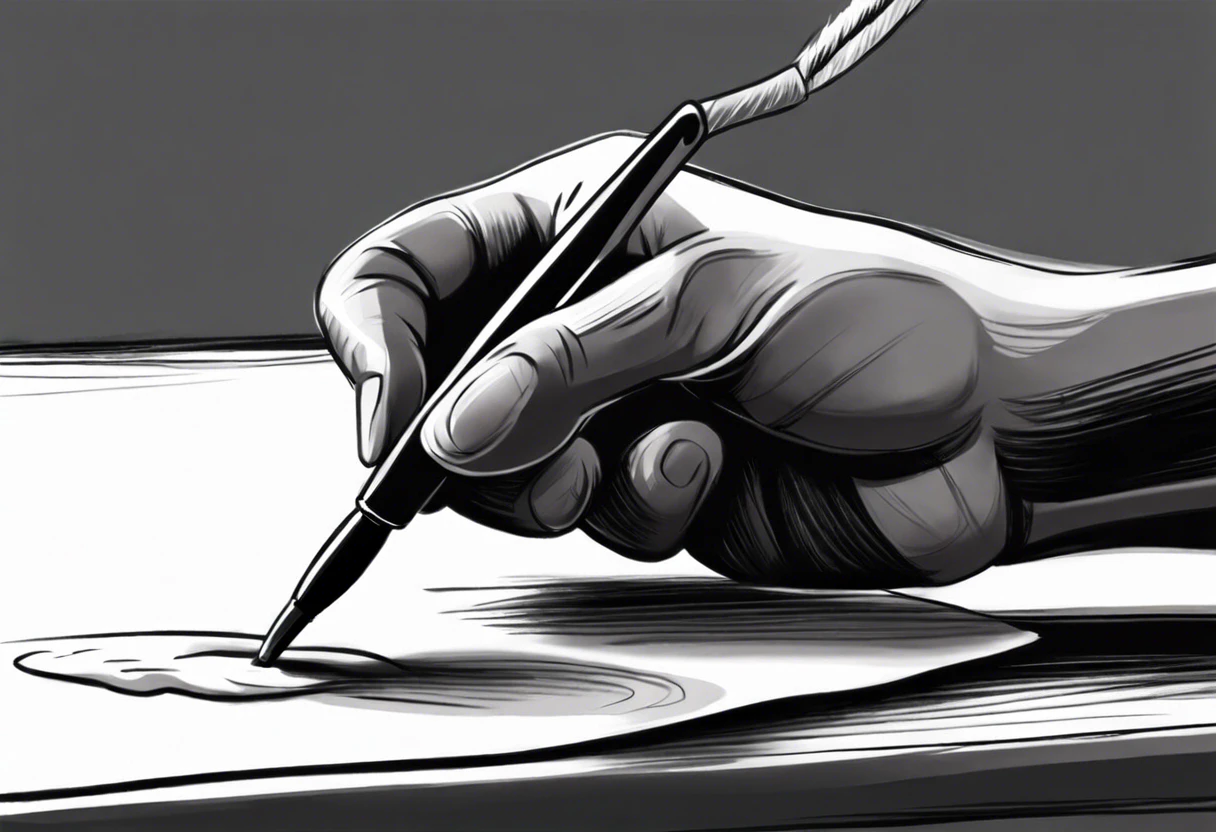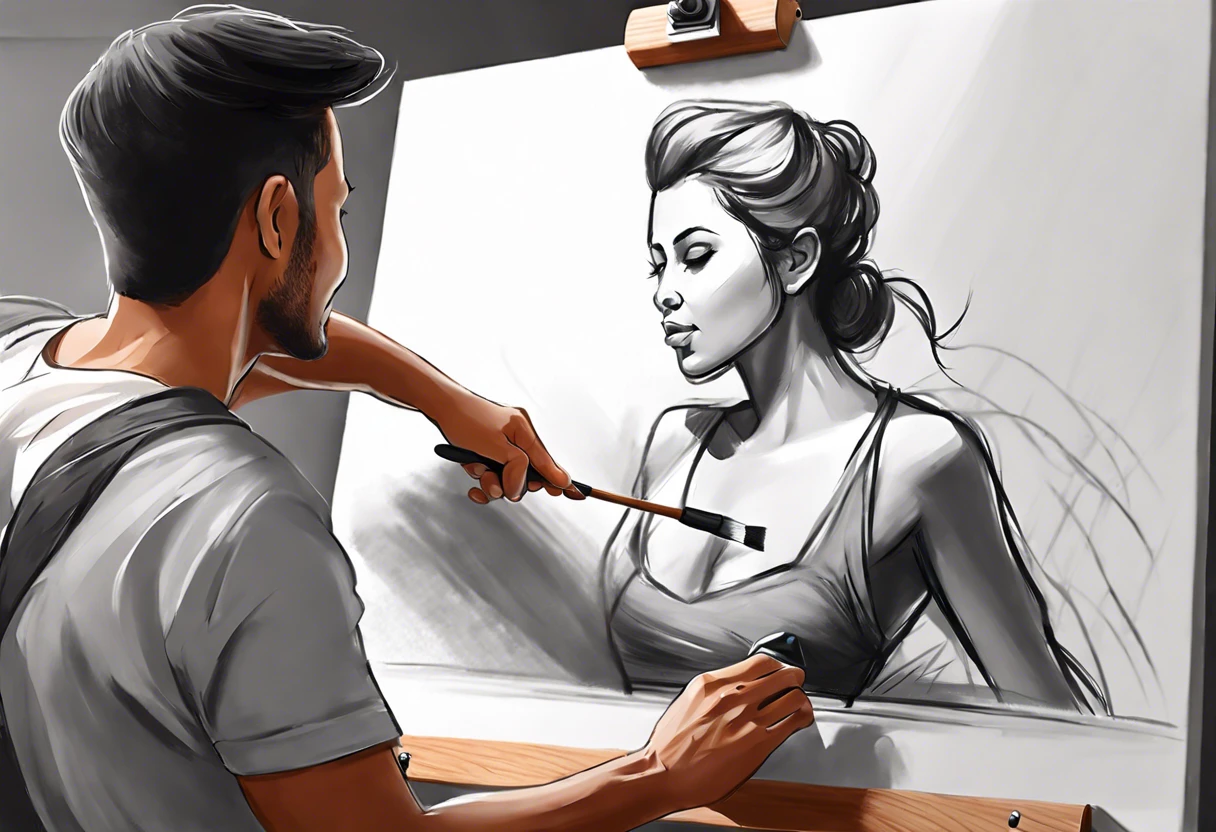How to Avoid Brush Strokes When Painting?
Published on: March 1, 2025 | Last Updated: January 7, 2025
Written By: Isabella Cruz
Brush strokes are the lines and marks left behind by your paintbrush. They can add character or mess up your art, making it look messy.
Knowing how to avoid brush strokes when painting is super important. Trust me, a smooth finish makes your artwork pop — I’ve seen it transform my pieces time and again!
In this guide, you’ll learn essential preparations before painting, a step-by-step approach to keep your surfaces smooth, the right blending techniques for a flawless finish, and the best brush types for that silky look, along with common challenges to watch out for when trying to minimize brush marks while painting.
Contents
- 1 How to Avoid Brush Strokes When Painting?
- 2 What Are Brush Strokes?
- 3 Essential Preparations Before You Start Painting
- 4 Step-by-step Guide to Avoiding Brush Strokes
- 5 Techniques for Smooth Application Without Brush Strokes
- 6 Understanding the Importance of Paint Viscosity
- 7 Experimenting with Paint Application Tools
- 8 Choosing the Right Environment for Painting
- 9 Types Of Brushes to Consider for Smooth Finishes
- 10 Factors Affecting Brush Stroke Visibility When Painting
- 11 Common Issues When Trying to Avoid Brush Strokes
- 12 Finishing Touches to Perfect Your Painting
- 13 DIY Project Ideas to Practice Brush Stroke-free Techniques
- 14 Frequently Asked Questions About Brush Strokes in Painting
- 15 Conclusion
- 16 Additional Resources
How to Avoid Brush Strokes When Painting?
To avoid brush strokes when painting, use a quality brush and thin your paint. Apply paint in even strokes and finish with a light stroke in one direction. Work quickly, and don’t overwork areas. Try a foam roller for smooth finishes.
The Finishing Touch
A freshly painted wall is a blank canvas. The best way to bring your room to life is with a single piece of statement art that ties everything together.
Browse Wall Art at Big Wall DecorWhat Are Brush Strokes?
Brush strokes are the visible marks left by a brush when applying paint. They vary in size, shape, and texture, often depending on the brush type. For example, a flat brush typically leaves broader strokes, while a round brush creates thinner ones.
You can control brush strokes by practicing techniques and choosing the right materials. In my experience, using a good-quality synthetic brush has significantly reduced brush strokes when painting.
A colleague found it useful for painting molding without brush strokes. She said that swirling paint with the right brush helps eliminate marks and creates a smoother finish. The quality of acrylic paint also plays a crucial role. Knowing how to avoid brush strokes with acrylic paint can save you countless hours in touch-ups!
Essential Preparations Before You Start Painting
What do you need to avoid brush strokes?
- High-Quality Paintbrush: Use a synthetic brush, like the Wooster Silver Tip, for water-based paints. It helps achieve smooth strokes.
- Matte Finish Paint: Choose a paint like Behr Premium Plus with a matte finish. It reduces gloss and minimizes the appearance of brush strokes.
- Painter’s Tape: Use reliable options like FrogTape to create clean edges. It prevents paint bleed and improves visual sharpness.
- Paint Roller: Use a high-nap, lint-free roller, like the Purdy White Dove Roller, for larger areas. It ensures even coverage and reduces brush usage.
We’ve wrapped up key preparations for painting here. Let us turn our attention to a detailed guide on preventing brush strokes.
Also See: What is the Lowest Temperature You Can Paint Outside?

Step-by-step Guide to Avoiding Brush Strokes
Follow these steps to eliminate brush strokes while painting.
-
Choose the Right Brush
Select a synthetic or natural bristle brush based on your paint type. For water-based paints, I usually choose a synthetic brush that’s 1-2 inches (2.54-5.08 Cm) wide for smooth finishes.
Ensure the bristles are soft to distribute the paint evenly and reduce marks. For acrylic paints, use a flat brush for better surface coverage.
-
Use Quality Paint
Opt for paint with high viscosity and low shear rate for a smoother finish. High-quality acrylic or oil-based paints adhere better and create a streamlined look.
Paints with a satin or semi-gloss finish can better conceal minor imperfections and strokes than matte finishes. Spend a few extra dollars on good paint—your project will benefit!
-
Prepare the Surface Properly
Surface preparation is crucial. Start with a clean, dry surface and sand it lightly to create an excellent base for the paint.
Using a primer can help eliminate brush strokes. Let all layers dry completely between applications for the best results.
-
Employ the Right Technique
Dip only the tip of your brush into the paint. Too much paint can lead to pesky brush strokes—I’ve been there!
Use long, even strokes and blend with a lighter touch. Work quickly to avoid letting the paint dry before finishing your strokes.
-
Apply Multiple Thin Coats
Start with thin layers and gradually build coverage. Applying two to three lighter coats provides a richer finish without streaks.
Ensure each coat is fully dry before applying the next—it can take 1 to 4 hours, depending on the paint and humidity!
We’ve wrapped up methods to avoid brush strokes here. Let us turn our attention to techniques for smoother application.
The Finishing Touch
A freshly painted wall is a blank canvas. The best way to bring your room to life is with a single piece of statement art that ties everything together.
Browse Wall Art at Big Wall DecorTechniques for Smooth Application Without Brush Strokes
Mastering various techniques is key in avoiding brush strokes. Let’s dive into effective methods that can help you achieve a flawless finish.
1. The “W” Technique
This technique consists of creating a “W” shape with your brush. Fill in the shapes while keeping the strokes light.
- Start by creating a “W” pattern on the surface.
- Then, blend the areas inside the “W” without lifting your brush.
- This technique helps distribute paint smoothly, minimizing marks.
2. Use of a Paint Sprayer
A paint sprayer can deliver a smooth, consistent finish in less time. Want to know how?
- Ensure you hold the sprayer about 12 inches (30.48 cm) from the surface.
- Keep your movements steady, overlapping each pass slightly.
- This method virtually eliminates brush strokes, even on large areas.
3. Brush Control Techniques
Controlling your brush can make a world of difference. Here are some pointers:
- Use a light touch. Let the brush glide instead of pressing hard.
- Start from the top and work your way down, which helps gravity assist in smooth application.
| Technique | Description | Benefits |
|---|---|---|
| The “W” Technique | Create a “W” shape for even paint distribution. | Minimizes brush strokes and enhances coverage. |
| Paint Sprayer | Use a sprayer for quick and smooth application. | Nearly eliminates brush strokes; great for large areas. |
| Brush Control | Maintain a light touch and steady strokes. | Ensures smooth application and less tension in strokes. |
So far we covered methods for a flawless finish without brush marks. Let’s look at the significance of paint thickness next.
Understanding the Importance of Paint Viscosity
Paint viscosity plays a crucial role in avoiding brush strokes. Let’s break it down.
1. What is Viscosity?
Viscosity is a measure of a fluid’s thickness or resistance to flow. The lower the viscosity, the thinner the paint, making it easier to spread smoothly.
2. Recommended Viscosity Levels
Here are some general viscosity guidelines for different paint types:
| Paint Type | Recommended Viscosity (mPas) | Characteristics |
|---|---|---|
| Acrylic Paint | 100-200 | Ideal for smooth application and quick drying. |
| Oil-Based Paint | 200-300 | Provides a rich finish but takes longer to dry. |
| Latex Paint | 150-250 | Best for indoor projects; easy cleanup and low VOCs. |
3. Adjusting Viscosity
Need to adjust your paint’s viscosity? Here’s how:
- Thinning Agents: Add water for acrylics, or turpentine for oil-based paints. A rule of thumb is to thin by 10-20%.
- Mixing Techniques: Stir well to ensure even consistency. Use a stir stick or a paint mixer for best results.
We covered the significance of paint viscosity and its effects here. We will now cover tools for applying paint effectively.

Experimenting with Paint Application Tools
Different tools can influence the texture of your paint. Here are some options to consider.
1. Foam Rollers
Foam rollers spread paint evenly over large areas. They’re great for achieving a smooth finish without brush strokes. I’ve had amazing results using a 4-inch (10.16 cm) foam roller for smaller projects!
2. Pallet Knives
Using a pallet knife gives you a unique texture without creating brush strokes. This is perfect for adding dimension to your artwork.
The Finishing Touch
A freshly painted wall is a blank canvas. The best way to bring your room to life is with a single piece of statement art that ties everything together.
Browse Wall Art at Big Wall Decor3. Specialized Brushes
Look for brushes labeled as “streak-free” or “smooth finish.” These can drastically reduce brush strokes. A flat edge or angular design does wonders!
Choosing the Right Environment for Painting
Your painting environment can impact the resulting brush strokes. Let’s explore how.
1. Lighting Conditions
Good lighting helps you notice imperfections immediately. Consider these tips:
- Natural light is best. It highlights flaws better than artificial light.
- Avoid painting in direct sunlight; it can dry paint too quickly.
2. Room Temperature and Humidity
Control these factors to ensure your paint flows nicely:
- Ideal temperature is around 21°C (70°F) with 40-50% humidity.
- Too much humidity can make paint take longer to dry, leading to runs.
Types Of Brushes to Consider for Smooth Finishes
Let’s look at brush types: Flat, Round, Filbert, and Angle brushes.
-
Flat Brushes
Flat brushes have rectangular bristles that are great for even stroke application. They help prevent brush strokes when painting large areas by distributing paint uniformly across surfaces.
-
Round Brushes
Round brushes are ideal for detail work and blending. Their pointed tips allow for precise application, which is essential for acrylic paint and helps eliminate brush marks in intricate designs.
-
Filbert Brushes
Filbert brushes combine the qualities of flat and round brushes, offering versatility. They excel at softening edges, which is crucial for painting molding without brush strokes, achieving a seamless look.
-
Angle Brushes
Angle brushes have slanted edges, making them ideal for corners and trim. Their design reduces brush marks when painting, especially in tight spaces where precision is essential.
I prefer filbert brushes for their versatility and ability to create smooth transitions without visible brush strokes.
Factors Affecting Brush Stroke Visibility When Painting
What factors influence your ability to paint without leaving unsightly brush strokes?
-
Brush Quality: A high-quality brush spreads paint evenly, reducing brush stroke visibility.
-
Paint Consistency: Thicker paints are more likely to show brush marks; thinning them with water or medium can help.
-
Application Technique: Using long, smooth strokes eliminates uneven patches and minimizes brush marks.
-
Surface Preparation: Properly primed and sanded surfaces let paint glide smoothly, preventing brush strokes.
Common Issues When Trying to Avoid Brush Strokes
Once, my friend struggled with visible brush strokes while painting a canvas. She tried quick strokes but ended up with uneven textures. Frustrating, right?
To fix this, use a high-quality synthetic brush (About 1 Inch or 2.54 Cm), thin your paint with a medium (Like Pouring Medium), and work in small sections. This approach can effectively eliminate brush marks! Professional painters often worry about surface imperfections that might compromise their work’s finish. If you’re concerned about potential paint damage during cleaning, protecting your paint’s integrity becomes crucial.
Finishing Touches to Perfect Your Painting
After mastering techniques, make sure your paint’s fully cured before any final touches. Wait at least 24 hours for latex or up to 7 days for oil-based paint.
Inspect your surface closely. Look for areas where brush strokes are visible under different lighting—like sunlight or lamps. I find that using a $10 LED work light helps identify flaws quickly.
Here’s a pro tip from my past projects: Use a finishing spray, like satin varnish, from a distance of 30 cm (12 in) for an ultra-smooth touch-up.
DIY Project Ideas to Practice Brush Stroke-free Techniques
How about crafting a textured wall panel using a palette knife, or creating a unique, brush-free canvas using a sponge? Both ideas are fresh and will challenge your artistic skills in the best way!
To tackle these projects, I’d grab some acrylics, a canvas, and decent quality sponges or palette knives. You might spend around $30-50 over a weekend, depending on what you already own.
Want more tips on how to avoid brush strokes when painting? Try using a paint sprayer for a smooth finish or apply paint with old credit cards for a cool, vibrant effect. If you’re curious about alternative painting techniques, these methods can help you achieve professional results. Trust me, both methods work wonders!
Frequently Asked Questions About Brush Strokes in Painting
How Can I Minimize Brush Strokes on Walls?
To minimize brush strokes on walls, you can use a high-quality brush or applicator designed for smooth finishes. These tools help distribute paint evenly. A foam roller, for instance, reduces streakiness since it holds more paint and applies it uniformly.
What Paint Brands Are Best Known for Smooth Application?
Some of the best paint brands known for smooth application are Benjamin Moore, Sherwin-Williams, and Behr. These brands offer premium lines with advanced technology that improves paint flow and finish quality, reducing the appearance of brush strokes significantly. If you encounter stubborn paint residue, you might want to explore effective paint removal techniques.
Can I Use a Roller Instead Of a Brush to Avoid Streaks?
Yes, you can use a roller instead of a brush to avoid streaks. Rollers create even coverage and work great on large surfaces. Plus, they leave behind a smoother finish compared to traditional brushes, making them ideal for walls. If you’re wondering about using specific solvents like acetone on painted surfaces, acetone can damage car paint and requires careful handling.
Is It Necessary to Sand Between Coats?
Yes, sanding between coats is necessary for achieving a super smooth finish. This process removes imperfections and enhances paint adhesion, leading to a more professional look. Use a fine-grit sandpaper, like 220-grit, for best results. If you’re looking to apply these techniques to other surfaces like tile backsplashes, painting tile requires similar preparation techniques.
What is the Best Way to Clean Brushes After Painting?
The best way to clean brushes after painting is to rinse them under warm water while using mild soap. This helps break down paint residue, especially for water-based paints. Proper cleaning extends the life of your brushes and maintains their performance. When you need specific techniques for preserving your painting tools, professional methods can make a significant difference.
How to Store Paint Brushes Overnight?
To store paint brushes overnight, wrap them in plastic wrap or aluminum foil to keep them moist. This prevents the bristles from drying out and preserves their shape. Alternatively, you can place them in a container of water, bristle-side down. If you’re working with acrylic paints, you might want to explore specific storage techniques for acrylic paint brush maintenance.
What Are the Benefits Of Using Water-based Paints to Reduce Brush Strokes?
Using water-based paints can significantly reduce brush strokes during your painting project. They have lower viscosity, allowing smoother application and quicker drying times, which minimizes streaks. A paint with less than 100 g/L volatile organic compounds (Vocs) also ensures better indoor air quality without sacrificing finish quality. When you’re done painting, proper brush maintenance is crucial to preserve your tools, so cleaning brushes thoroughly prevents damage.
Also See: What Color to Paint Inside Of Front Door? Ideas!
Conclusion
Phew, we covered a lot on how to avoid brush strokes when painting, including essential preparations, brush types, recommended color palettes, and common issues.
To achieve a flawless finish while painting, it’s important to use the right techniques and tools, such as selecting the ideal brush and practicing smooth application. If you need further assistance in reducing brush marks, feel free to reach out.
For more comprehensive guides and tutorials, visit Paint Answers.
Additional Resources
- Betti, C., & Sale, T. (2012). Drawing: A Contemporary Approach (6th ed.). Belmont, CA: Cengage Learning.
- Brush Marks – 5 Pro Tips on How to Avoid Paintbrush Lines
- How to Minimize Brush Strokes on your Painted Furniture
Isabella is a Filipino-American art writer and critic specializing in contemporary painting, blending her Filipino heritage with global art trends. She holds a BFA from California State University, Long Beach, and a Minor in Art History from the University of the Philippines. Isa has experience as a Gallery Assistant, Art Appraisal Specialist, and Social Media Creative for Art & Design.
Blending, Topics









